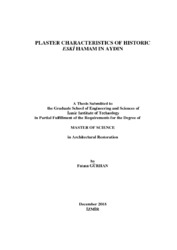Please use this identifier to cite or link to this item:
https://hdl.handle.net/11147/7178Full metadata record
| DC Field | Value | Language |
|---|---|---|
| dc.contributor.advisor | Böke, Hasan | |
| dc.contributor.author | Gürhan, Fatma | - |
| dc.date.accessioned | 2019-07-16T08:43:13Z | |
| dc.date.available | 2019-07-16T08:43:13Z | |
| dc.date.issued | 2018-12 | en_US |
| dc.identifier.citation | Gürhan, F. (2018). Plaster characteristics of historic Eski Hamam in Aydın. Unpublished master's thesis, Izmir Institute of Technology, Izmir, Turkey. | en_US |
| dc.identifier.uri | https://hdl.handle.net/11147/7178 | |
| dc.description | Thesis (Master)--Izmir Institute of Technology, Architectural Restoration, Izmir, 2018 | en_US |
| dc.description | Includes bibliographical references (leaves: 86-91) | en_US |
| dc.description | Text in English; Abstract: Turkish and English | en_US |
| dc.description.abstract | Aydın Eski Hamam is a typical example of Ottoman period bath buildings. It had been built during 15th-16th centuries, and subjected to extensive interventions by present. The building was registered in 2001, and excavation, cleaning and measured surveys were carried out in 2016-2017. The aim of this study is to determine the characteristics of the horasan and lime plasters of Eski Hamam. Within this purpose, horasan and lime plasters, joint mortars and building bricks were collected from the bath. Basic physical properties, raw material compositions, microstructural and hydraulic properties of plasters, mineralogical and chemical compositions of binders and aggregates, and pozzolanic activities of aggregates were determined by standard test methods, XRD and SEM-EDS analyses in order to shed light on the restoration implementations. The results revealed that all the studied samples were of low density and high porosity. Physical, chemical and microstructural properties of plasters did not differ according to the space, level and layer they had been used. Horasan plasters had been prepared by using pure lime and brick aggregates. Lime plasters used on the upper levels had been produced by using pure lime and small amount of fine sand. Horasan plasters were hydraulic due to the use of pozzolanic aggregates. Brick aggregates had been manufactured by using raw material sources containing high amounts of clay minerals, and fired at low temperatures. Lime plasters and mortars had hydraulic properties due to the use of pozzolanic natural aggregates. | en_US |
| dc.description.abstract | Aydın Eski Hamam, konumu, planlama özellikleri, yapım tekniği ve malzeme özellikleri ile Osmanlı Dönemi hamam yapılarının tipik bir örneğidir. Yapıdan gelen izlerden ve mimari özelliklerinden 15 ile 16. yüzyıl başlarında inşa edildiği anlaşılan hamam, daha sonra sıcaklık mekanı ve çeşme eklenmesi gibi kapsamlı müdahaleler görmüştür. 2001 yılında tescil edilen yapıda 2016-2017 yıllarında kazı, temizlik ve rölöve çalışmaları gerçekleştirilmiştir. Bu çalışmanın amacı, Eski Hamam’da kullanılmış horasan ve kireç sıvaların özelliklerinin belirlenmesidir. Bu amaçla, yapının soyunmalık-ılıklık, sıcaklık mekanlarının ve su deposunun farklı seviyelerinden ve sıvaların farklı katmanlarından sekiz horasan sıva, beş kireç sıva, iki kireç harcı ve iki yapı tuğlası örnekleri alınmıştır. Restorasyon uygulamasına ışık tutmak amacıyla örneklerin temel fiziksel özellikleri, hammadde kompozisyonları, mikroyapısal ve hidrolik özellikleri; bağlayıcı kısımların ve agregaların mineralojik ve kimyasal kompozisyonları ile agregaların puzolanik aktiviteleri standart test yöntemleri, XRD ve SEM-EDS analizleri ile belirlenmiştir. Elde edilen sonuçlara göre, incelenen sıvaların tamamı düşük yoğunluklu ve yüksek gözenekli malzemelerdir. Horasan ve kireç sıvaların fiziksel, kimyasal ve mikroyapısal özellikleri kullanıldıkları döneme, mekana, seviyeye ve katmana göre farklılık göstermemektedir. Horasan sıvaları 1/2 ile 1/1 arasında değişen oranlarda, saf kireç ile tuğla agregalarla, üst seviyelerde uygulanmış kireç sıvalar ise %93-97 arasında değişen oranlarda saf kireç ve çok az miktarda ince kum ile üretilmiştir. Agrega olarak kullanılan tuğlaların puzolanik özellikte olmalarından dolayı horasan sıvalar hidroliktir. Bu tuğlalar, yüksek miktarlarda kil içeren hammadde kaynaklarından hazırlanmış ve düşük sıcaklıklarda (< 900ºC) pişirilmişlerdir. Kireç sıvalarda ve harçlarda kullanılan doğal agregalar da puzolanik olduğundan kireç sıva ve harçlar da hidrolik özelliktedirler. | en_US |
| dc.format.extent | xviii, 155 leaves | en_US |
| dc.language.iso | en | en_US |
| dc.publisher | Izmir Institute of Technology | en_US |
| dc.rights | info:eu-repo/semantics/openAccess | en_US |
| dc.subject | Conservation and restoration | en_US |
| dc.subject | Historic preservation | en_US |
| dc.subject | Baths, Turkish | en_US |
| dc.subject | Eski Hamam | en_US |
| dc.subject | Plasters | en_US |
| dc.title | Plaster characteristics of historic Eski Hamam in Aydın | en_US |
| dc.title.alternative | Aydın'da bulunan tarihi Eski Hamam'ın sıva özellikleri | en_US |
| dc.type | Master Thesis | en_US |
| dc.institutionauthor | Gürhan, Fatma | - |
| dc.department | Thesis (Master)--İzmir Institute of Technology, Conservation and Restoration of Cultural Heritage | en_US |
| dc.relation.publicationcategory | Tez | en_US |
| item.languageiso639-1 | en | - |
| item.fulltext | With Fulltext | - |
| item.openairecristype | http://purl.org/coar/resource_type/c_18cf | - |
| item.openairetype | Master Thesis | - |
| item.grantfulltext | open | - |
| item.cerifentitytype | Publications | - |
| Appears in Collections: | Master Degree / Yüksek Lisans Tezleri | |
Files in This Item:
| File | Description | Size | Format | |
|---|---|---|---|---|
| T001858.pdf | MasterThesis | 23.68 MB | Adobe PDF |  View/Open |
CORE Recommender
Page view(s)
174
checked on Jul 22, 2024
Download(s)
102
checked on Jul 22, 2024
Google ScholarTM
Check
Items in GCRIS Repository are protected by copyright, with all rights reserved, unless otherwise indicated.